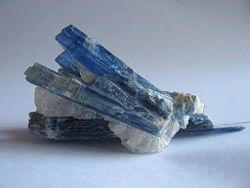Kyanite
| Kyanite | |
|---|---|
 |
|
| General | |
| Category | Mineral |
| Chemical formula | Al2SiO5 (aluminum silicate) |
| Identification | |
| Color | Blue; also green, white, grey, black |
| Crystal habit | Columnar; fibrous |
| Crystal system | Triclinic |
| Cleavage | [100] Perfect, [010] Imperfect |
| Fracture | Brittle |
| Mohs Scale hardness | 4.5-5 parallel to one axis 6.5-7 perpendicular to that axis |
| Luster | Vitreous; Pearly |
| Refractive index | 1.71 - 1.75 |
| Pleochroism | Trichroic, colorless to pale blue to blue |
| Streak | White |
| Specific gravity | 3.56 - 3.67 |
| Solubility | None |
| Diaphaneity | Transparent to translucent |
Kyanite is a member of the aluminosilicate subgroup of silicate minerals. It is typically blue, but its color may vary. It is used in porcelain plumbing fixtures, dinnerware, electrical insulators, and abrasives. It has also been used as a gemstone, and it is a collector's mineral.
Etymology and alternative names
The name kyanite derives from the Greek word kyanos, meaning blue. This mineral is also known by several alternative names, including disthene, munkrudite, and cyanite. White-gray kyanite is also called rhaeticite.
Occurrence
Kyanite is commonly found in aluminum-rich metamorphic pegmatites and sedimentary rocks. It is a diagnostic mineral of the Blueschist Facies of metamorphic rocks.
Characteristics
Kyanite has two polymorphs: andalusite and sillimanite. Kyanite and its polymorphs have the same chemical formula, Al2SiO5, but they differ in crystalline structure.
An interesting property of kyanite is that it undergoes irreversible expansion when fired at high temperature. In addition, this mineral is strongly anisotropic, in that its hardness varies depending on its crystallographic direction.
Identifying traits
Kyanite's elongated, columnar crystals are usually a good first indication of the mineral, as well as its color (when the specimen is blue). Associated minerals are useful as well, especially the presence of the polymorphs or staurolite, which occur frequently with kyanite. However, the most useful characteristic in identifying kyanite is its anisotropism. If one suspects a specimen to be kyanite, verifying that it has two distinctly different values of hardness on perpendicular axes is a key to identification.
Associated minerals
Kyanite is usually found in association with its polymorphs and other silicate minerals. They include:
- andalusite, Al2SiO5
- sillimanite, Al2SiO5
- quartz, SiO2
- staurolite, Fe2Al9Si4O22(OH)2
- micas, AB2-3(X, Si)4O10(O,F,OH)2
- garnets, A3B2(SiO4)3
Uses of kyanite
Kyanite is used primarily in refractory and ceramic products, including porcelain plumbing fixtures and dinnerware. It is also used in electrical insulators and abrasives. Kyanite has also been used as a gemstone, though this use is limited by its anisotropism and perfect cleavage. Finally, as with most minerals, kyanite is a collector's mineral.
See also
ReferencesISBN links support NWE through referral fees
- Deer, W.A., R.A. Howie, and J. Zussman. 1996. An Introduction to the Rock-Forming Minerals. 2nd ed. Upper Saddle River, NJ: Prentice Hall. ISBN 0582300940
- Farndon, John. 2006. The Practical Encyclopedia of Rocks & Minerals: How to Find, Identify, Collect and Maintain the World's best Specimens, with over 1000 Photographs and Artworks. London: Lorenz Books. ISBN 0754815412
- Klein, Cornelis, and Barbara Dutrow. 2007. Manual of Mineral Science. 23rd ed. New York: John Wiley. ISBN 978-0471721574
- Pellant, Chris. 2002. Rocks and Minerals. Smithsonian Handbooks. New York: Dorling Kindersley. ISBN 0789491060
- Schumann, Walter. 2006. Gemstones of the World. 3rd ed. New York: Sterling. ISBN 1402740166
- Shaffer, Paul R., Herbert S. Zim, and Raymond Perlman. 2001. Rocks, Gems and Minerals. Rev. ed. New York: St. Martin's Press. ISBN 1582381321
External links
All links retrieved June 16, 2018.
- Kyanite Mineral Data Webmineral.com.
- Kyanite Mindat.org.
Credits
New World Encyclopedia writers and editors rewrote and completed the Wikipedia article in accordance with New World Encyclopedia standards. This article abides by terms of the Creative Commons CC-by-sa 3.0 License (CC-by-sa), which may be used and disseminated with proper attribution. Credit is due under the terms of this license that can reference both the New World Encyclopedia contributors and the selfless volunteer contributors of the Wikimedia Foundation. To cite this article click here for a list of acceptable citing formats.The history of earlier contributions by wikipedians is accessible to researchers here:
The history of this article since it was imported to New World Encyclopedia:
Note: Some restrictions may apply to use of individual images which are separately licensed.
